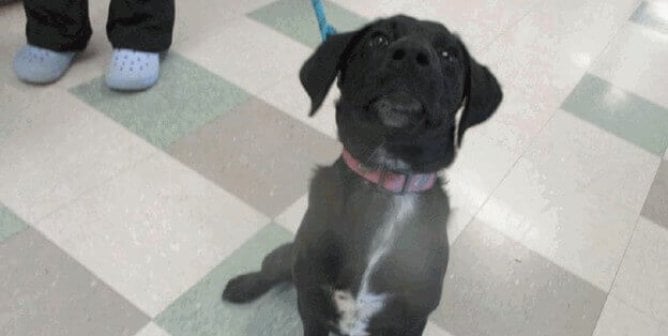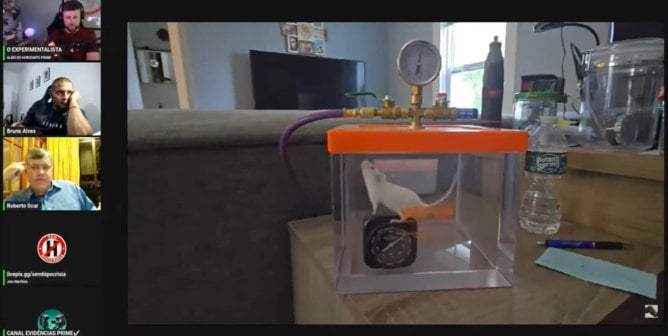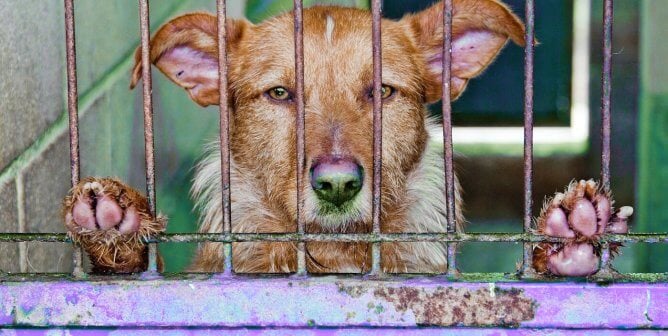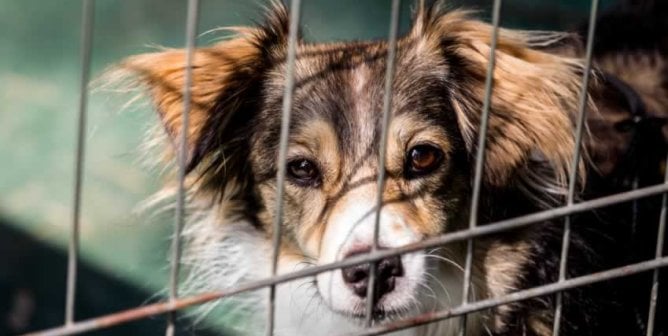Companion Animal Frequently Asked Questions
Does PETA believe that people shouldn’t have pets?
In a perfect world, all animals would be free from human interference and free to live their lives the way nature intended. They would be part of the ecological web of life, as they were before humans domesticated them. But the world that we live in is far from perfect, and domestic cats and dogs are not capable of surviving on their own, so it is our responsibility to take the best possible care of these animals. Please be assured that PETA does not oppose kind people who share their lives and homes with animal companions whom they love, treat well, and care for properly.
However, we very much oppose the puppy mills and private breeders that supply many companion animals; PETA is absolutely opposed to all breeding. In U.S. animal shelters alone, up to 4 million dogs, cats, puppies, and kittens are euthanized each year, simply because there aren’t enough homes for them. Given the astounding number of healthy and loving but unwanted animals who are being killed, we believe that breeding more animals merely to satisfy the desire for a particular behavioral or physical trait is absurd and selfish. We do, however, encourage those who have the desire, time, and patience to take good care of an animal to rescue homeless strays or adopt animals from a shelter. In fact, most PETA staff members live with animals who have been rescued from abuse or abandonment.
Read about more ways to provide rich, interesting lives for your animal companions.
If I am able to find homes for all the kittens or puppies, why shouldn’t I allow my cat or dog to have a litter?
While your intentions may be good, there’s no way of knowing what will happen to the animals once they have been adopted. This year, millions of healthy, wonderful animals will go through the front doors of animal shelters—and go out the back doors in body bags. Many more will be abandoned on the streets.
Read More
All this misery and death could be prevented through spaying and neutering (surgical sterilization). Every stray cat and neglected dog came from an animal who had not been spayed or neutered.
PETA works hard to educate the public about the importance of spaying and neutering through pamphlets, billboards, letters to the editor, ads, public service announcements, articles, and humane-education programs in schools. We also provide spaying and neutering services for the animal companions of low-income families and elderly people.
Read more about the dog and cat overpopulation crisis.
Don’t puppies in pet stores need homes just as much as puppies at animal shelters? Besides, how else can I choose the breed?
Many of the dogs sold in pet shops come from puppy mills and breeding kennels. In puppy mills, female dogs are kept in crude, outdoor cages with little protection from the rain, sweltering heat, bitter cold, or biting winds. They are denied companionship and comfort and treated like breeding machines. Their puppies are taken from them at an early age, packed into crates, and shipped hundreds of miles to dealers, often without adequate food, water, or ventilation.
Read More
Poor breeding practices lead to numerous health problems, including distemper, parvovirus, respiratory conditions, physical deformities, deafness, eye diseases, skin diseases, parasites, and a host of other ailments.
Once puppies arrive at pet stores, life in cramped cages adds more strain to their already stressed lives, increasing their susceptibility to disease. No law regulates how pet shops must dispose of animals, and some stores have been caught killing unsold dogs on the premises and throwing them into Dumpsters. While breeders churn out millions of puppies each year, millions of other animals are killed for want of a good home. Dogs are dumped at local pounds or abandoned in the woods and on city streets. Animal shelters are able to find loving homes for only a fraction of the animals they receive, and the rest must be put to death. Because of the overpopulation crisis, there is no such thing as “responsible” breeding.
If you have the time, energy, space, and money to care for a dog (or two), please visit your local animal shelter and adopt. Mixed-breed dogs are typically healthier than purebred dogs, but you can usually find purebred dogs at animal shelters as well if you have your heart set on a particular breed.
Read about PETA’s undercover pet shop investigation.
Rather than euthanizing dogs and cats, couldn’t we just build more animal shelters?
Shelters do not provide a solution to the problem of companion animal homelessness because dogs and cats need more than food, water, and shelter from the elements. They need and deserve loving care, regular human companionship, respect for their individuality, and the opportunity to play and run.
Read More
As difficult as it may be for us to accept, euthanasia (carried out by veterinarians or trained shelter professionals via intravenous injection of sodium pentobarbital) is often the most compassionate and dignified way for unwanted animals to leave this uncaring world.
Read about the positive and negative aspects of animal shelters.
Isn’t it better to declaw a cat than to give him or her away?
If you asked your cats if it would be OK to put them through 10 separate, painful amputations that would weaken their legs, shoulders, and back muscles, they would probably say, “No”—and they wouldn’t be alone. Many veterinarians in the U.S. and abroad refuse to declaw cats. In fact, in Germany and some other parts of Europe, declawing is illegal.
Read More
Cats who have been declawed experience extreme pain when they awake after surgery, and they have difficulty walking until their paws heal. Without their claws, cats are virtually defenseless, and this can lead to neuroses and even skin and bladder problems.
With the aid of a scratching post and firm, consistent instructions about where they may and may not scratch, cats can easily be taught not to scratch furniture.
Read more about declawing and kind alternatives.
What is PETA’s position on euthanasia?
Every day in the U.S., tens of thousands of puppies and kittens are born. Compare this to the 11,000 human births each day, and it’s clear that at this rate, there will never be enough homes for all these animals. Animal shelters are stuck with the heart-rending job of dealing with unwanted animals.
Read More
People who refuse to spay and neuter their animals, those who abandon animals when they grow tired of them, and those who patronize pet shops instead of adopting stray animals or animals from shelters make euthanasia a tragic necessity.
Read the causes of and solutions for the cat and dog overpopulation crisis.
What does PETA think about trapping, altering, releasing, and monitoring feral cats?
Sadly, our experiences with trap, alter, release, and monitor programs and “managed” feral cat colonies have led us to question whether these programs are truly in the cats’ best interests. We receive countless reports of incidents in which cats—whether “managed” or not—suffered and died horrible deaths because they were forced to fend for themselves outdoors. Having witnessed firsthand the gruesome things that can happen to feral cats, we cannot, in good conscience, advocate trapping, altering, releasing, and monitoring as a humane way to deal with overpopulation.
Read More
Advocates argue that feral cats are just as deserving as other felines and that it is our responsibility to alleviate their suffering and ensure their safety. We absolutely agree. It is precisely because we would never encourage anyone to let their own cats outdoors to roam that we do not encourage the same for feral cats. In fact, the act of releasing a cat is abandonment and is illegal in some areas.
Although altering feral cats prevents the suffering of future generations, it does little to improve the quality of life for those who are already fending for themselves outdoors. Thus, we believe that allowing feral cats to continue their daily struggle for survival in a hostile environment is not usually a humane option.
Nevertheless, PETA’s position has never been that all feral cats should be euthanized. We believe that it is acceptable to trap, vaccinate, alter, and release feral cats when the cats are isolated from roads, people, and other animals who could harm them; are regularly attended to by people who not only feed them but also provide them with veterinary care; and are situated in an area where they do not have access to wildlife and where the weather is temperate.
Read PETA’s feral cat factsheet to learn more.
What’s wrong with chaining dogs outside? Isn’t that better than having them run loose?
Condemning a dog to solitary confinement on a chain is so cruel that it is illegal in some cities. Chained dogs are exposed to sweltering heat, bitter cold, rain, and wind. Chaining puts dogs at risk for heat exhaustion, frostbite, and exposure-related health problems. Chains can wrap around trees or other objects, water bowls can easily tip over, and food can quickly spoil in summer or freeze in winter.
Read More
Chained dogs often become overly fearful of intruders and overly protective of their tiny patches of ground. They are easy targets for cruel people who taunt and tease them. As a result, many chained dogs become defensive and distrustful. Not surprisingly, dogs who spend much of their lives outdoors on chains often become dangerous, while dogs who are well socialized and supervised rarely bite.
Perhaps worst of all, chained dogs are terribly lonely. Dogs are pack animals who long to love, live with, and be loved by their human families. Denying a dog companionship is so cruel that some dogs are actually driven crazy by their loneliness. It’s best for everyone when dogs are treated as treasured family members.
Find out whether your city has a law against chaining dogs.
Why shouldn’t cats be allowed outdoors to explore and exercise?
Cats should be allowed outdoors for walks on leashes, just as dogs are, and to explore securely fenced yards. A product called Cat Fence-In, a flexible mesh barrier that can be attached to the tops of privacy fences can help prevent cats from climbing out and keep them safe in your yard.
Read More
Like dogs or small children, cats who are let outdoors without supervision are vulnerable to the dangers of cars, other animals, cruel people, and disease. Feline leukemia, feline AIDS, feline infectious peritonitis (FIP), toxoplasmosis, distemper, heartworms, and rabies can be difficult to detect and, in the case of FIP and distemper, impossible to test for. Most of these ailments are highly contagious and can easily be passed on to other companion animals.
Many people consider free-roaming cats to be pests. They do not want cats to urinate, defecate, dig, eat plants, or kill birds on their properties. Free-roaming cats have been shot, poisoned, and stolen by angry neighbors.
Fortunately, cats can live happy lives indoors. Learn how to make your indoor cat forget all about the great outdoors.
What’s wrong with keeping birds in cages?
All caged birds have either been captured or bred in captivity. In the wild, these beautiful beings are never alone, and if they are separated from their flock, even for a moment, they call wildly to their flockmates. These social animals preen each other, fly together, play, and share egg-incubation duties. Many species of birds partner for life and share parenting tasks. In the wild, most birds will not take a second partner if they lose their first.
Read More
Life in captivity is often a death sentence for birds, who may suffer from malnutrition, loneliness, and the stress of confinement to improper environments. Birds are meant to fly and be with others of their own kind in a natural environment. Confinement causes birds to have temper tantrums and mood swings. The Los Angeles Times reported that parrots “quickly become frustrated ‘perch potatoes’ in captivity. … Many end up obese and with serious behavioral problems such as screaming, biting, and self-mutilation by plucking out their feathers.” James Serpell, director of the Center for the Interaction of Animals and Society at the University of Pennsylvania says, “Parrots are the primates of the bird world. They aren’t content to sit on a perch and sing.”
Birds are smuggled into the U.S. more frequently than any other animal. Before being shipped, many birds are force-fed, their wings are clipped, their beaks are taped shut, and they are crammed into containers ranging from luggage to spare tires to hide them. It’s not unusual for 80 percent of the birds in a shipment to die.
Birds taken from the wild pose a health threat to both humans and domesticated animals. Parrots can transfer potentially deadly psittacosis to humans. Exotic Newcastle disease (END), which devastated whole flocks of chickens and turkeys in the 1970s, was believed to have been brought to the U.S. by South American parrots who were smuggled in for the pet trade. More recently, Mexican parrots who were smuggled into California were suspected to have caused an outbreak of END, leading to the government-sponsored slaughter of more than 3 million chickens and turkeys. “We’re not trained to detect diseases,” said a U.S. Fish and Wildlife inspection officer.
Captive-bred birds don’t fare much better. Birds who are older than 8 to 10 weeks don’t sell well at pet shops. As a result, many are kept for breeding and condemned to small cages for the rest of their lives.
If you love birds, contact a bird-rescue group in your area to learn how you can foster or adopt an abused or neglected bird.
Read more about the captive-bird industry.








